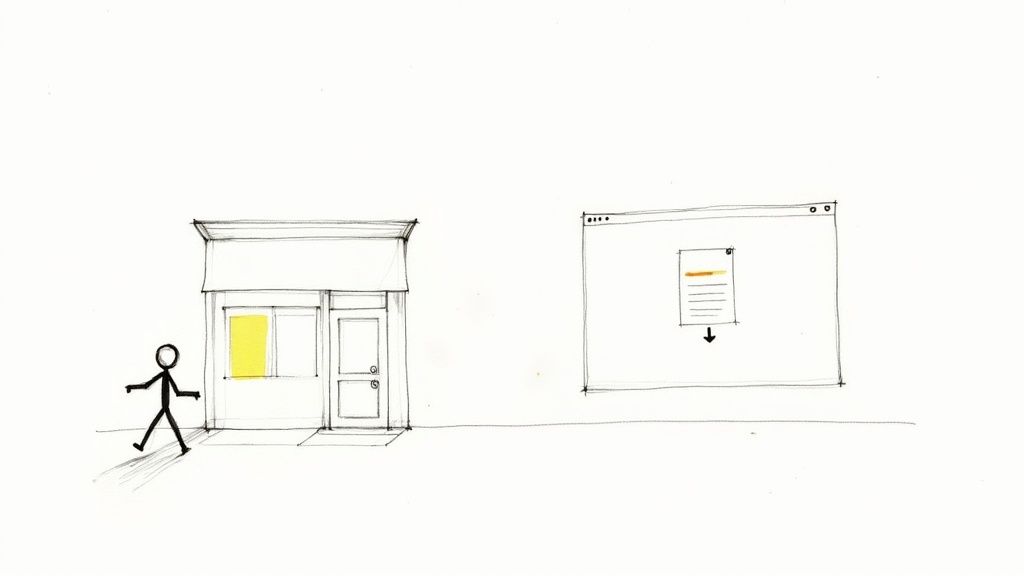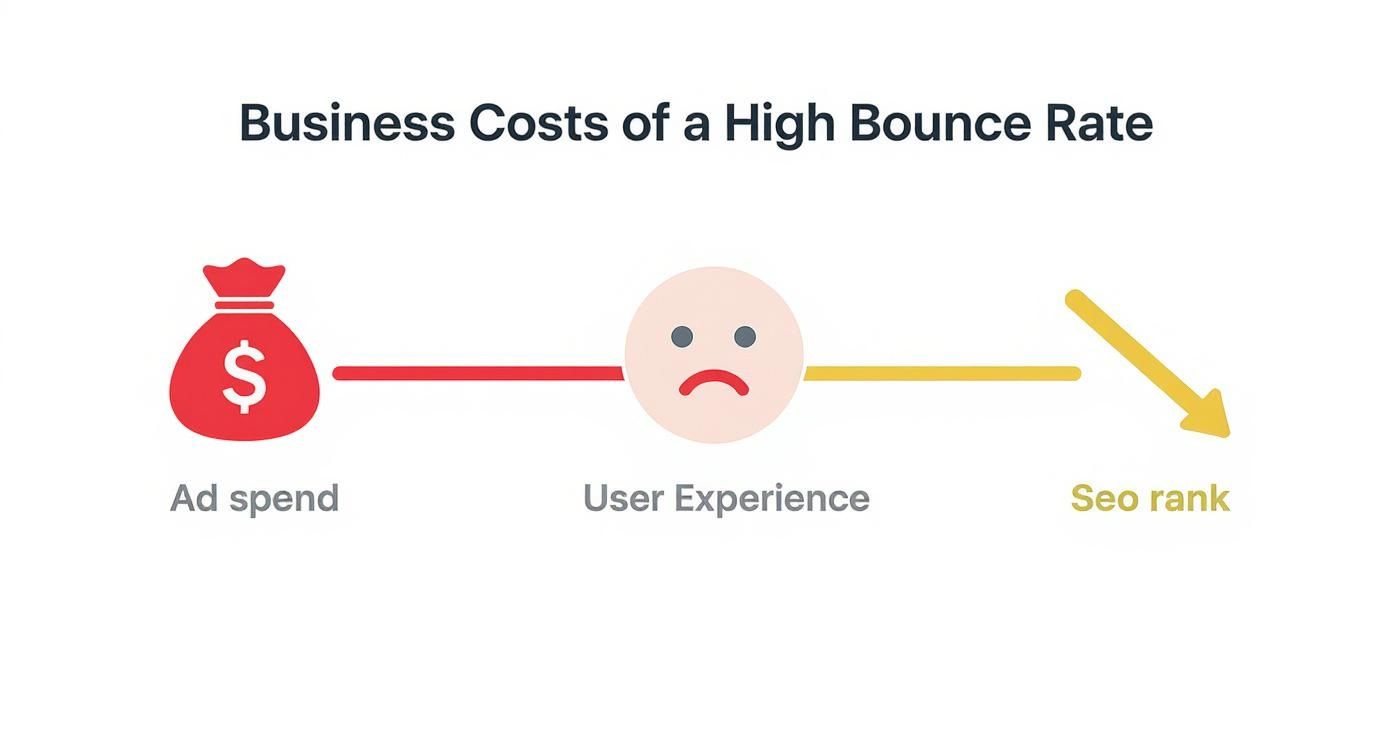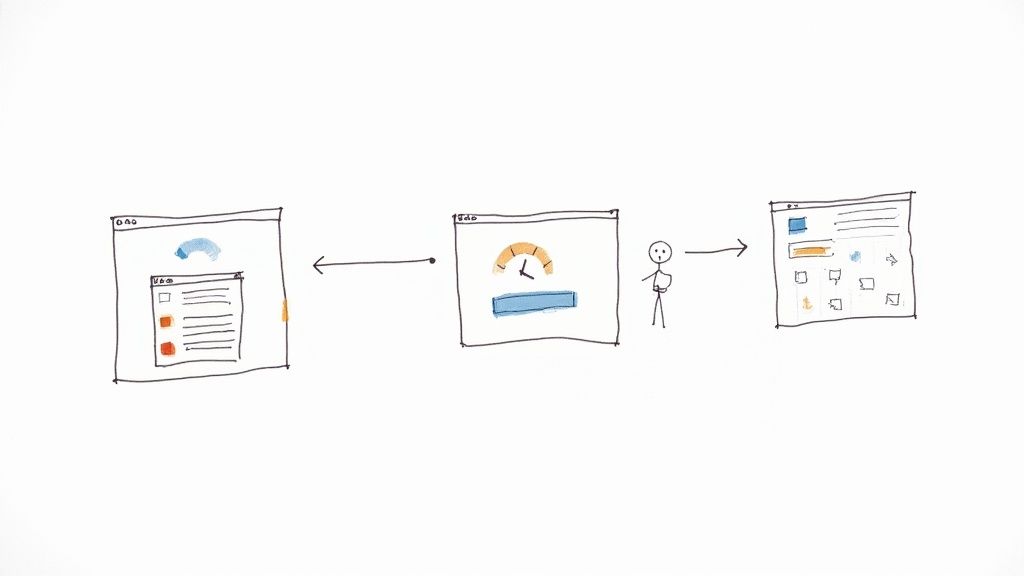What is Bounce Rate? And How to Get Visitors to Stick Around
Let's get this sorted out, shall we? Bounce rate is just the percentage of people who land on your website and then leave without clicking on anything else. Imagine someone walking into your Kelowna shop, glancing around for a second, and then walking right back out the door. That’s a bounce.
So What Is Bounce Rate Anyway?

We've all done it. You click a link, hoping to find one thing, but the page shows you something completely different. What do you do? You hit the 'back' button without thinking twice.
That quick exit is what we call a bounce. In the web analytics world, a bounce happens when someone visits one of your pages and leaves without doing anything else. They don’t click to your services page, they don’t read your "About Us" story, and they definitely don’t fill out your contact form.
It’s a one-and-done visit.
How Is It Calculated?
You don’t need to be a math whiz for this one, promise. It's the total number of single-page visits (bounces) divided by the total number of visits to your site.
So, if 100 people visit your site in a day and 45 of them leave without clicking a single link, your bounce rate for that day is 45%. You’ll find this number in your website analytics reports.
Think of bounce rate as your website’s first impression score. It gives you a huge clue about whether you’re meeting a visitor's expectations the moment they arrive.
This number tells a really important story about how well your page connects with the person who just landed on it. A high bounce rate might mean your message is unclear, your page is painfully slow to load, or the content just isn’t what they were looking for.
Why This Number Matters
Knowing what a bounce rate is is the first step. The real work is figuring out what it’s telling you about your business. This is more than just a number on a dashboard; it’s direct feedback from your potential customers. Digging into these figures is a key part of any solid web analytics strategy.
This metric helps us answer some big questions, like:
-
Is our marketing message aligned? Do the ads we’re running in the Okanagan match the landing pages they lead to?
-
Is the user experience smooth? Can people easily find what they’re looking for, or is the design confusing and frustrating?
-
Is our content hitting the mark? Does it actually give people the answers they’re searching for?
Getting a handle on your bounce rate helps you make real, meaningful improvements to your website that can have a big impact on your bottom line.
Why Should You Care About a High Bounce Rate?
Okay, so people land on your website and leave right away. You might be thinking, "What's the big deal?" But a high bounce rate is more than just a number in your analytics report. It's a clear signal that something is getting in the way of you connecting with potential customers.
Think about all the effort and money that goes into getting people to your site. Every click from a Google Ad or a social media campaign costs something. When those visitors hit your page and immediately click the back button, that's your advertising budget vanishing into thin air. It’s like paying for a prime billboard in Kelowna, only to have it facing a brick wall.
The Real Costs of a Bouncy Website
A high bounce rate often points to deeper problems that can quietly chip away at your business's success. For instance, here in Canada, the average bounce rate for a commercial website usually hovers somewhere between 48% and 53%. When your numbers start creeping up past that, it’s a good time to investigate. You can read more about how bounce rates impact Canadian businesses on mycodelesswebsite.com.
Usually, the culprit is one of these common issues:
-
A Frustrating User Experience: Is your site painfully slow to load? Is the navigation a confusing mess? People have very little patience online; they won't stick around to solve a puzzle. They'll just leave.
-
Mismatched Expectations: This happens all the time. Your ad makes a specific promise, but your landing page talks about something else entirely. That immediate disconnect is a recipe for a bounce.
-
A Poor First Impression: An outdated design, a giant wall of text, or a layout that looks broken on a phone can make your business seem unprofessional. Trust is lost before it even has a chance to form.
The Quiet SEO Impact
If that wasn't enough, a high bounce rate can also drag down your SEO efforts. Think about it from a search engine's perspective: their goal is to serve up the best, most relevant results for any given search.
When users consistently land on your page and immediately leave, it tells search engines that your content probably wasn't what they were looking for. Over time, this can lead to lower rankings, pushing your site down in favour of competitors who do a better job of holding a visitor's attention. That makes it much harder for new customers in the Okanagan to find you.
What's a Good Bounce Rate? Well, It Depends
So, what number should you be aiming for? It's the first question everyone asks, and the honest answer is… it’s not that simple. What’s considered a "good" bounce rate can change a lot from one industry to another. A number that signals a problem for an e-commerce store might be perfectly healthy for a local news blog.
Context is everything here. Think about it: someone might search for a specific answer, land on your blog post, find exactly what they need in the first couple of paragraphs, and leave completely satisfied. In your analytics, that’s a bounce. But was it a bad visit? Not at all. The goal is to understand what's normal for a business like yours.
Finding Your Industry Benchmark
To get a clearer picture, let's look at some typical ranges. A deep dive into website behaviour across Canada shows just how much bounce rates can vary depending on what a site offers.
For example, Canadian blogs and news portals often have high bounce rates, typically between 65% and 80%. This makes sense, as people usually drop in to read a single article and then carry on with their day. On the other hand, corporate and government websites might see bounce rates as low as 35% to 42%, because they're designed for users to dig deeper and find specific information across multiple pages.
To make this even more practical, here’s a quick look at average bounce rates across different types of websites to give you a helpful benchmark.
Typical Bounce Rates for Canadian Businesses by Industry
| Industry / Website Type | Average Bounce Rate Range |
|---|---|
| E-commerce & Retail | 20% – 45% |
| B2B / SaaS | 25% – 55% |
| Lead Generation | 30% – 55% |
| Service-Based (e.g., plumbers, lawyers) | 35% – 60% |
| Content & News Portals | 40% – 65% |
| Landing Pages | 60% – 90% |
| Blogs | 65% – 90% |
Seeing where you fit in helps set realistic expectations. A high bounce rate isn't just an abstract number; it often points to bigger issues that can quietly eat away at your budget and stunt your growth.

As you can see, this isn't just a number you can ignore. It has real costs that can directly affect your bottom line.
Your bounce rate is a starting point—a clue that helps you ask better questions about how people are really using your site.
Knowing how you stack up against others in your field gives you a solid baseline. From there, you can start digging into the "why" and work on creating a better experience for your visitors.
Common Reasons Your Visitors Are Bouncing
Alright, let's play detective. When your bounce rate is high, it’s not just random chance—it’s a clear signal that something on your site is turning visitors away. Think of it like a lineup at your shop's till; if it’s too long, people will walk out without a second thought.
One of the biggest culprits is almost always a slow-loading page. If your website takes more than a couple of seconds to pop up, most visitors are already hitting the back button. Nobody has time for that.
Another huge factor is a clunky or confusing user experience. Can people find your contact details or your list of services without having to think about it? If your navigation is a maze, you're just creating frustration, especially for anyone browsing on their phone.
The Most Common Suspects
Pinpointing the exact reason for a high bounce rate often just means looking at your site through a visitor’s eyes. It almost always boils down to a few common, fixable problems.
-
Painfully Slow Page Speed: People expect near-instant loading times. Even a few seconds of delay can send your bounce rate through the roof.
-
A Terrible Mobile Experience: Your site might look incredible on a desktop, but if it's a jumbled mess on a phone, you've got a serious problem. Our guide on best practices for mobile content is a great place to start tackling this.
-
Confusing Website Navigation: If a potential customer can’t figure out how to get from your homepage to your services, they're not going to hang around and try to solve the puzzle.
-
Content That Misses the Mark: Did your ad promise one thing but your landing page delivered something else entirely? This kind of mismatch is a surefire way to make someone bounce.
Technical Glitches and Mobile Woes
How your site performs on a technical level is a massive piece of this puzzle. Here in Canada, studies have shown a direct link between site performance and how long people stick around. Sites that take longer than 3 seconds to load can see bounce rates jump over 60%, while snappy sites often hover closer to 35%.
With mobile bounce rates in Canada averaging around 51%, a poor mobile setup can quickly become your single biggest issue.
A high bounce rate isn’t a judgment—it’s a road sign. It points you directly to the parts of your website that need a little more care and attention to truly connect with your visitors.
Practical Ways to Lower Your Bounce Rate

Alright, we’ve talked enough about the problem. Let’s shift gears and focus on the solutions. Understanding what is bounce rate is one thing, but actually doing something about it is what matters. And the great news is that a few smart changes can make a massive difference.
You don't need to tear down your entire website and start from scratch. Often, it's the small, consistent improvements that convince visitors to hang around and see what else you have to offer.
Start With The Simple Stuff
Sometimes, the easiest fixes deliver the biggest results. Before you get lost in a major redesign, let's look at the basic pieces of your website. A few tweaks here can completely change how visitors feel about your site.
-
Improve Your Page Speed: Nobody waits for a slow website. If your page takes more than a couple of seconds to load, people are gone. Compressing your images and cleaning up your code can make your site feel lightning-fast.
-
Make Navigation Crystal Clear: Your main menu should be dead simple. A visitor from Penticton should be able to find your services page in one or two clicks, max. No guesswork allowed.
-
Write Attention-Grabbing Headlines: Your headline is your first—and sometimes only—impression. It needs to instantly tell visitors they've found what they're looking for. Make it powerful and clear.
Guide Visitors Deeper Into Your Site
Once you’ve got their attention, your next job is to point them toward other valuable content on your site. This is where a little bit of on-page strategy really pays off.
One of the best ways to do this is with internal linking. All this means is adding links from one page on your site to another relevant page. For instance, a blog post about a project should link directly to the service page that explains how you did it. It’s a natural way to say, “Hey, if you found this interesting, you’ll love this too.”
We recently helped a client in Vernon lower their bounce rate by over 20%. The secret? We just added a clear call-to-action and a handful of strategic internal links to their most popular blog posts. A tiny change with a huge impact.
These little nudges keep people clicking, show them the breadth of your expertise, and can turn a single page view into a genuine connection. It's a fundamental part of creating a website that doesn't just attract traffic but actually converts it. To learn more about this, check out our guide on what is conversion rate optimization—it explains how these small adjustments drive big business results.
Common Questions We Hear About Bounce Rate
Let's tackle some of the most common questions that come up when we talk about bounce rate. We hear these a lot, so you’re not alone in wondering.
Is a 100% Bounce Rate a Red Flag?
Not always, and this is a really important thing to understand. It all comes down to the page's purpose.
Think about it this way: someone in Kelowna searches for your business, lands directly on your contact page, grabs your phone number, and immediately calls you. In Google Analytics, that's a 100% bounce. But for your business, that's a perfect conversion! They got what they needed and took action. Context is everything.
What’s the Difference Between Bounce Rate and Exit Rate?
This one trips people up all the time, but the difference is pretty simple once you see it.
-
Bounce Rate: This only counts visitors who land on a page and leave without visiting any other pages. It’s a one-and-done visit.
-
Exit Rate: This tells you the percentage of visitors who left your site from a specific page, no matter how many other pages they visited during their visit.
A high exit rate on the final page of your checkout process is a huge problem. But a high bounce rate on a blog post where someone found the exact answer they needed? That might be perfectly fine.
Does Bounce Rate Directly Impact SEO Rankings?
The short answer is no, but the real answer is a bit more complicated.
Google has said that bounce rate isn't a direct ranking factor. However, a consistently high bounce rate can be a sign of a larger problem, like a poor user experience, slow page speed, or content that doesn't match what the user was searching for. Since search engines want to provide a great user experience, a site that people constantly "bounce" from is unlikely to rank well long-term.
When It's Time to Call in the Pros
So you've tweaked your headlines, compressed your images, and simplified your navigation… but that stubborn bounce rate just won't budge. It’s frustrating, right? You know your website could be doing more for your business, but you've hit a wall.
A high bounce rate that refuses to improve often signals a deeper issue. It might be a technical glitch, a confusing user journey, or a subtle messaging mismatch that’s almost impossible to spot when you're too close to the project. It’s like trying to proofread your own writing; a fresh set of eyes can make all the difference.
Getting an Outside Perspective
When you've exhausted your own bag of tricks, bringing in an expert team can be a game-changer. It means you can stop throwing things at the wall to see what sticks and start using strategies based on solid data and years of experience. You get to focus on what you do best—running your business—while we handle the deep dive.
A great partner acts as an extension of your team, dedicated to turning those quick visits into meaningful customer connections. It’s about more than just fixing a number; it’s about building a website that actively fuels your growth.
If you feel like you're spinning your wheels, let's talk. The team here at Navigator loves digging into these kinds of challenges for our clients throughout the Okanagan. We can help you figure out what's really going on and build a plan to turn those bounces into real customers. If you're ready for some expert help, we'd be happy to be your partner.
Ready to get your website working for you? Let's chat about your project.



